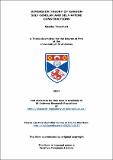Files in this item
Dimension theory of random self-similar and self-affine constructions
Item metadata
| dc.contributor.advisor | Falconer, K. J. | |
| dc.contributor.advisor | Todd, Michael John | |
| dc.contributor.author | Troscheit, Sascha | |
| dc.coverage.spatial | xiii, 124 p. | en_US |
| dc.date.accessioned | 2017-06-20T15:18:18Z | |
| dc.date.available | 2017-06-20T15:18:18Z | |
| dc.date.issued | 2017-06-23 | |
| dc.identifier.uri | https://hdl.handle.net/10023/11033 | |
| dc.description.abstract | This thesis is structured as follows. Chapter 1 introduces fractal sets before recalling basic mathematical concepts from dynamical systems, measure theory, dimension theory and probability theory. In Chapter 2 we give an overview of both deterministic and stochastic sets obtained from iterated function systems. We summarise classical results and set most of the basic notation. This is followed by the introduction of random graph directed systems in Chapter 3, based on the single authored paper [T1] to be published in Journal of Fractal Geometry. We prove that these attractors have equal Hausdorff and upper box-counting dimension irrespective of overlaps. It follows that the same holds for the classical models introduced in Chapter 2. This chapter also contains results about the Assouad dimensions for these random sets. Chapter 4 is based on the single authored paper [T2] and establishes the box-counting dimension for random box-like self-affine sets using some of the results and the notation developed in Chapter 3. We give some examples to illustrate the results. In Chapter 5 we consider the Hausdorff and packing measure of random attractors and show that for reasonable random systems the Hausdorff measure is zero almost surely. We further establish bounds on the gauge functions necessary to obtain positive or finite Hausdorff measure for random homogeneous systems. Chapter 6 is based on a joint article with J. M. Fraser and J.-J. Miao [FMT] to appear in Ergodic Theory and Dynamical Systems. It is chronologically the first and contains results that were extended in the paper on which Chapter 3 is based. However, we will give some simpler, alternative proofs in this section and crucially also find the Assouad dimension of some random self-affine carpets and show that the Assouad dimension is always `maximal' in both measure theoretic and topological meanings. | en_US |
| dc.language.iso | en | en_US |
| dc.publisher | University of St Andrews | |
| dc.rights | Attribution-NonCommercial-NoDerivatives 4.0 International | * |
| dc.rights.uri | http://creativecommons.org/licenses/by-nc-nd/4.0/ | * |
| dc.subject | Fractal geometry | en_US |
| dc.subject | Random attractors | en_US |
| dc.subject | Iterated function systems | en_US |
| dc.subject | Dimension theory | en_US |
| dc.subject.lcc | QA614.86T8 | |
| dc.subject.lcsh | Fractals | en |
| dc.subject.lcsh | Attractors (Mathematics) | en |
| dc.subject.lcsh | Dimension theory (Topology) | en |
| dc.title | Dimension theory of random self-similar and self-affine constructions | en_US |
| dc.type | Thesis | en_US |
| dc.contributor.sponsor | Engineering and Physical Sciences Research Council (EPSRC) | en_US |
| dc.contributor.sponsor | Institute for Computational and Experimental Research in Mathematics (ICERM) | en_US |
| dc.contributor.sponsor | Instituto de Matemática Pura e Aplicada (Brazil) | en_US |
| dc.contributor.sponsor | Brazilian-European partnership in Dynamical Systems (BREUDS) | en_US |
| dc.type.qualificationlevel | Doctoral | en_US |
| dc.type.qualificationname | PhD Doctor of Philosophy | en_US |
| dc.publisher.institution | The University of St Andrews | en_US |
The following licence files are associated with this item:
This item appears in the following Collection(s)
Except where otherwise noted within the work, this item's licence for re-use is described as Attribution-NonCommercial-NoDerivatives 4.0 International
Items in the St Andrews Research Repository are protected by copyright, with all rights reserved, unless otherwise indicated.


